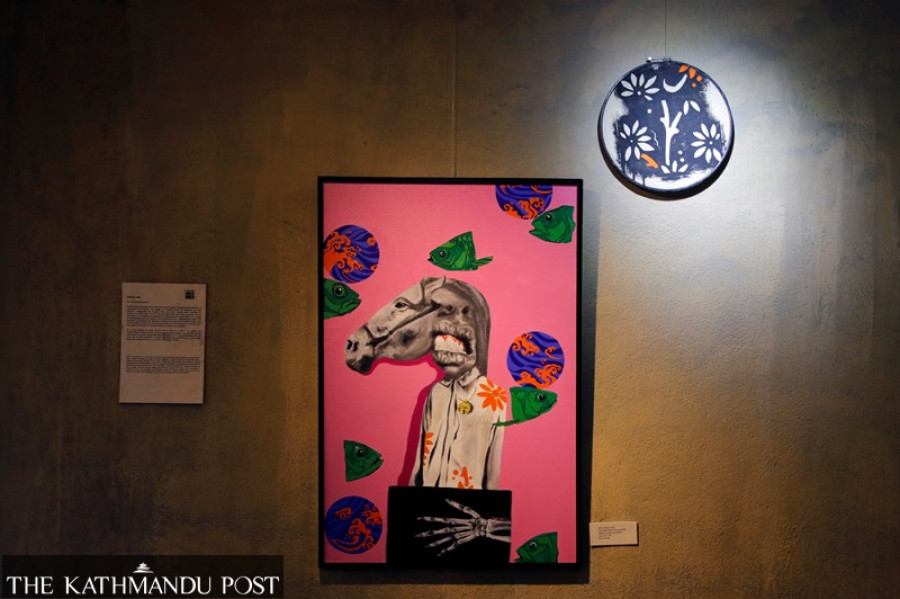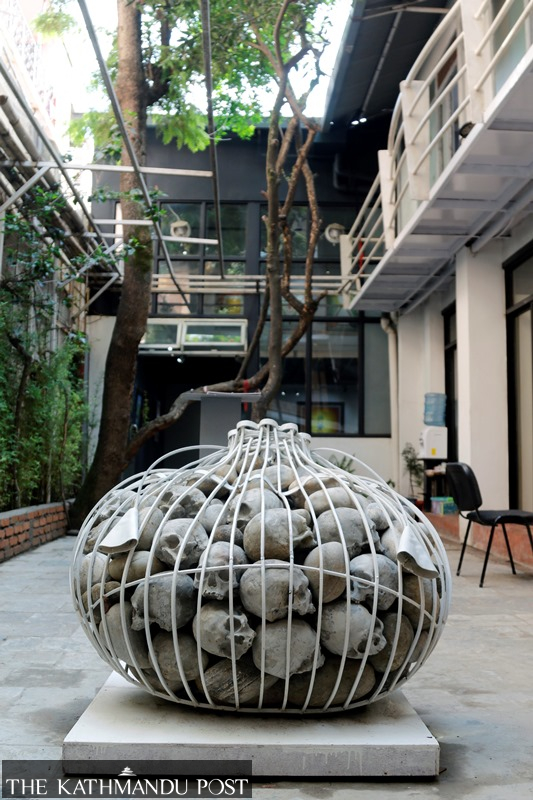Arts
Celebrating the evolution of Nepal’s contemporary art scene
Bikalpa Art Center’s latest interdisciplinary exhibition, ‘Revisiting the Roots in a Modern Nuance’, attempts to make sense of Nepal’s contemporary art scene journey.
Srizu Bajracharya
One of the paintings featured at the Gallery of Creatives, Thamel, features women from the Jyapu community sitting together on top of grains spread in a large cloth. Their gathering alongside scattered minute grains looks like an abstract pattern of black and red concentric circles from a bird's eye view.
If you let your imagination wander into the painting's world, you might even hear the women laughing and talking inside a tight-knit Newa neighbourhood.
This threaded artwork, titled ‘Mandala’, is the work of Sofiya Maharjan. The artwork uses the colours black and red distinctly to represent the ethnic attire haku patasi of the women of the Jyapu community, to which Maharjan belongs to.
Her artwork is part of Bikalpa Art Center’s (BAC) exhibition ‘Revisiting the Roots in a Modern Nuance’.
“When I was told the theme for the BAC’s exhibition was revisiting roots, my immediate intuition was going after colours that have defined my community’s identity for a long time. I wanted to play around with black and red, the two predominant colours of my childhood memories,” says a visibly excited Sofiya Maharjan.
“Being part of an exhibition that also features works of senior artists I have always looked up to has been an overwhelming experience. I have learned so much by participating in this exhibition, and I am so grateful for the exposure,” added Maharjan, who graduated with a Bachelor's degree in Fine Arts in 2020.
Twenty-two-year-old Maharjan is also the youngest participant in the extensive art exhibition that has been curated by Saroj Mahato, who has long dreamt of curating a large-scale local exhibition.
In ‘Revisiting the Roots in a Modern Nuance’, Mahato brings together more than 46 artists to draw a picture of the country’s contemporary art scene while letting the artists portray their own ideas of roots through modern techniques of art. The works of the 46 artists are spread over four art venues: Gallery of Creatives and Vidroh, both in Thamel, and Bikalpa Art Center and Park Gallery, both in Pulchowk.
“I don’t know exactly why, but I have always wanted to put together an exhibition that captures Nepal's contemporary art movement, which started in the early 60s,” said Mahato, on a recent afternoon at Bikalpa Art Center. “Our country’s artworks have evolved so much in the last seven decades, and many artists have tried to define the nuances of Nepali art while making their careers in art. I wanted to showcase artworks from different eras in one harmonised art world and bring a retrospective picture of all that has happened in the Nepali art scene.”
What is impressive about ‘Revisiting the Roots in a Modern Nuance’ is that the exhibition has been put together using minimal financial resources and relying primarily on collaboration with the artists involved. Every artist and gallery involved has contributed in whatever ways they could to make this exhibition a reality.
“I am glad that our exhibition has shown that sometimes all it takes is a strong will to organise an exhibition of this scale,” said Mahato. “When we think about projects like this, we often focus too much on available financial resources. But this exhibition shows the community's team spirit.”
Mahato’s attempt is also admirable as the exhibition, to an extent, successfully expresses the many issues the featured artists were exploring through art and tells the history of art movements, shifting art scenes to ideas of spirituality, religion, and indigenous identity. The exhibition also attempts to make viewers understand how people have come to understand art.

At Vidroh, Thamel, the works of artists Kiran Maharjan, Dibeshwar Gurung, Srijan Ulak, and Ashin Gurung are featured, and the artworks are staggeringly different from those in other art venues of the exhibition. The works of the four artists focus on urban and street art culture and bring street/mural art elements to their canvases to highlight the alternative urban art movement that has been evolving next to the mainstream contemporary art movement since 2010.
“For urban artists, the exhibition is an opportunity to engage the audience with an art scene that started just about twelve years ago,” said Romel Bhattarai, the founder of Vidroh.
“Events like these are important because they motivate and demand us to challenge ourselves as artists. They give us exposure. They also provide younger artists with an opportunity to network so that they can push their works out there in the world. And so, when Saroj came to us with the idea of the exhibition, we said why not,” added Bhattarai.
With works of legendary Nepali senior artists—Lain Singh Bangdel, Ram Nanda Joshi, Manuj Babu Mishra, Indra Pradhan, Birendra Pratap Singh, Shashi Bikram Shah, Batsa Gopal Vaidya—placed alongside those of young and emerging artists, the exhibition creates an opportunity for viewers to understand the subtle differences between the art ideas of various artists. One can also distinctly see that the works of senior artists are influenced by their understanding of religion, spirituality and their need to identify what Nepali art is.
The artworks featured in the exhibition also makes for a seeming transition in how the young artists view art and use art tools to explore their own identities and relationship with their culture and communities. It also makes apparent that the younger generation of artists have looked more inwards as they explore themselves as artists. These young artists don’t shy from sharing what is personal to them, although that means being vulnerable in front of their audience.
One such young artist in the exhibition is Rupesh Man Singh from the Film Foundry, an art collective. In his series ‘Still Frames’, Singh uses printed black and white photos of his late grandfather to express the void he feels when looking at the images and how family photographs as art also capture relationships and their histories.
“Growing up, I lived in a hostel for many years, and whenever I came home for holidays, I would feel very detached from my family. But when I discovered our family’s photo album, it became a way to overcome the gap in my relationship with my family. It helped me mend my relationship with my family. That is why I have been exploring familial relationships through my work. But at the same time, this endeavour has helped me practise and approach photography differently,” said Singh in a phone conversation with the Post.
Like Maharjan, Singh believes the exhibition has been a fantastic opportunity to understand the Nepali art scene and the works of many artists that he has only read and heard about.
“I think this exhibition is an opportunity for artists and many studying arts to know how contemporary art has developed through the years. The representation of works is massive in this exhibition. You can see the journey of photography, visual and urban arts, and grasp the endless possibilities of art in the future,” said Singh.
Apart from exhibiting artworks, the organisers have also put together workshops and panel discussions on different art issues to make the exhibition more engaging.
“We didn’t want the exhibition to be limited to just a display of artworks. We also wanted to engage people in conversations about art, which is vital to grow Nepal’s art scene. And I think these engagements have helped us bring more audience to our galleries,” said Mahato.
This coming Saturday, the organising team is also hosting a performance art programme by artists like Mahima Singh, Sundar Lama, Ram Mahajan, and Dawa Sherpa at Naka Bahi, Patan.
Many artists participating in the exhibition say that they are pleasantly surprised by how big the event has become.
“Once various aspects of the exhibition finally came together, I finally realised the event's scale,” said Singh, the artist from Film Foundry.
Organising an event of this scale, says Mahato, wouldn't have been possible without the art community's support.
“The outpour of support from the art community has been incredible. Given that many in the art community have always wanted to see something similar happen, many came forward and helped in whatever ways they could. This spirit made the job so much easier,” said Mahato, beaming with his gratifying smile.
“And now I am just thinking about all the possibilities if we all make a collective effort. I am just so happy right now!" said Mahato. "Aren’t you happy to see this? And now I just want people to come and enjoy the show and then talk about our art history.”




 22.65°C Kathmandu
22.65°C Kathmandu










